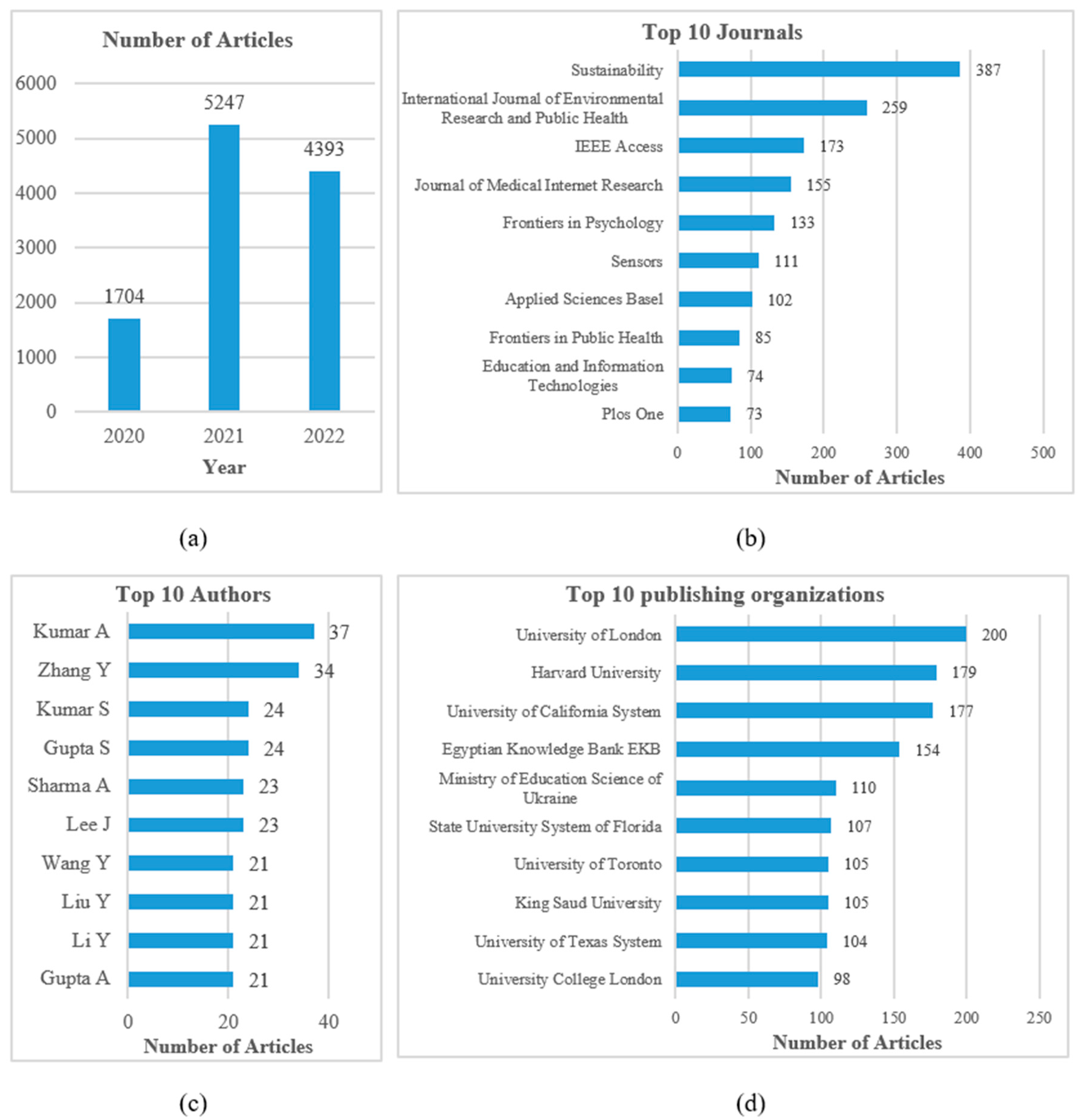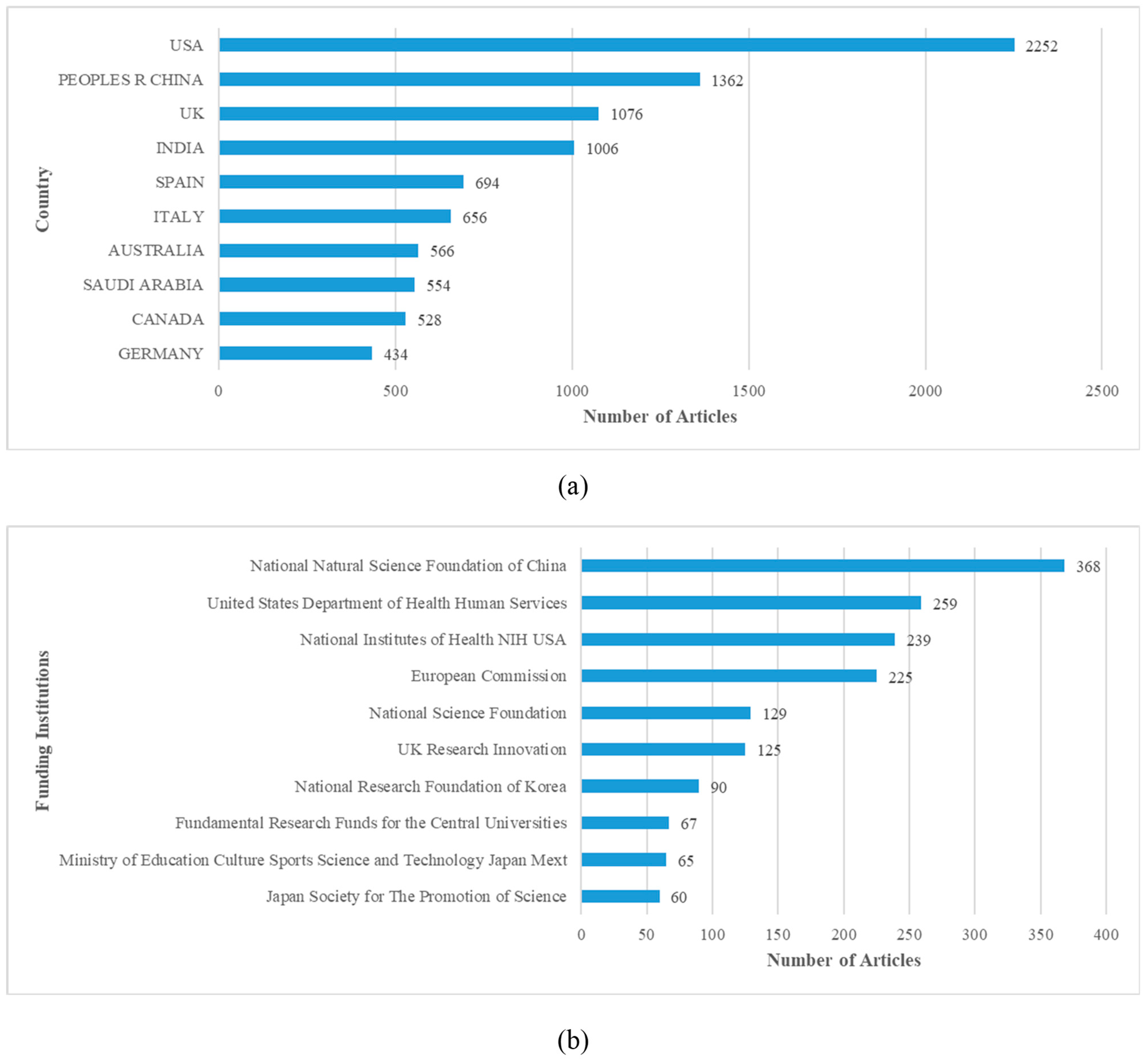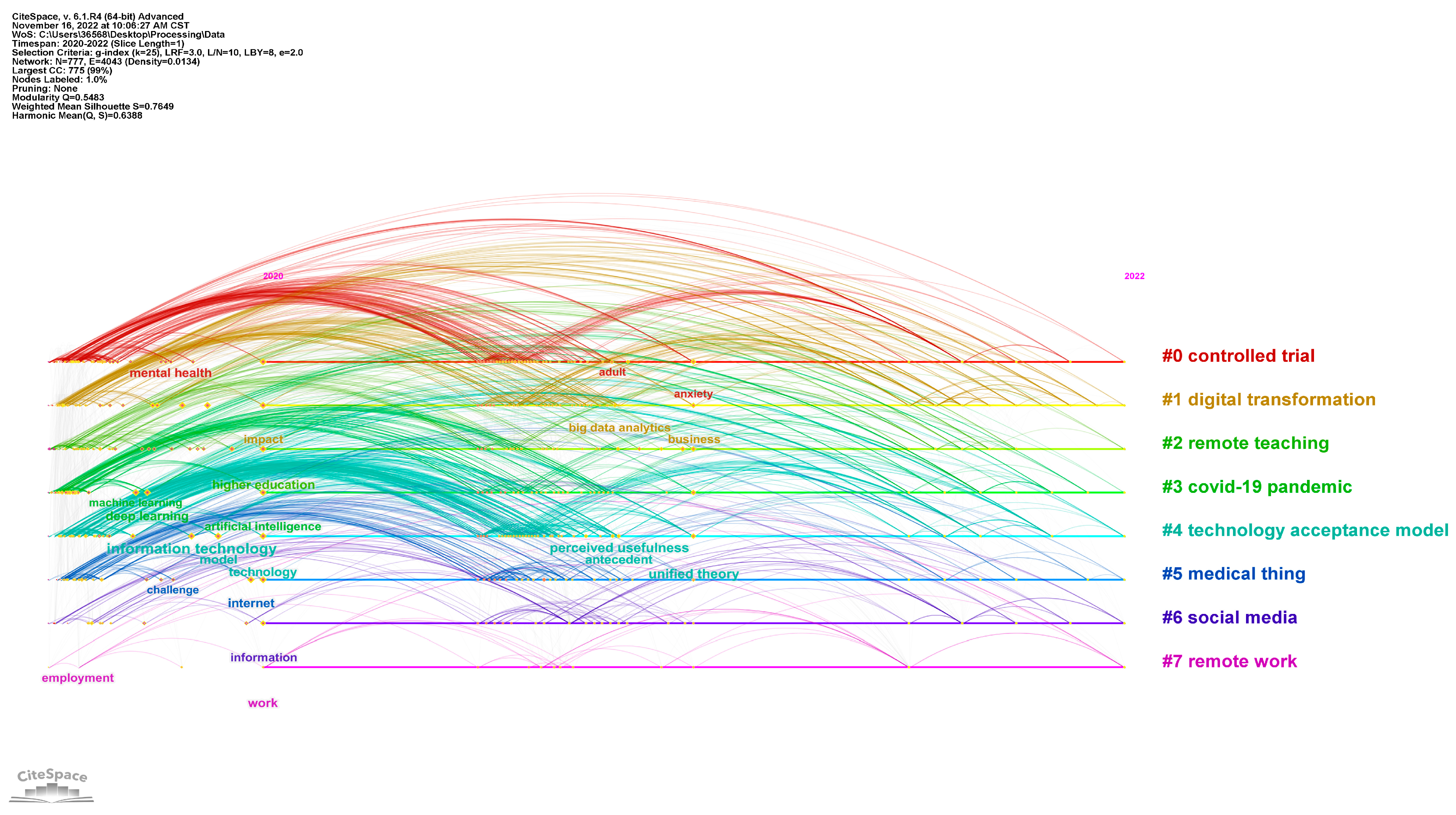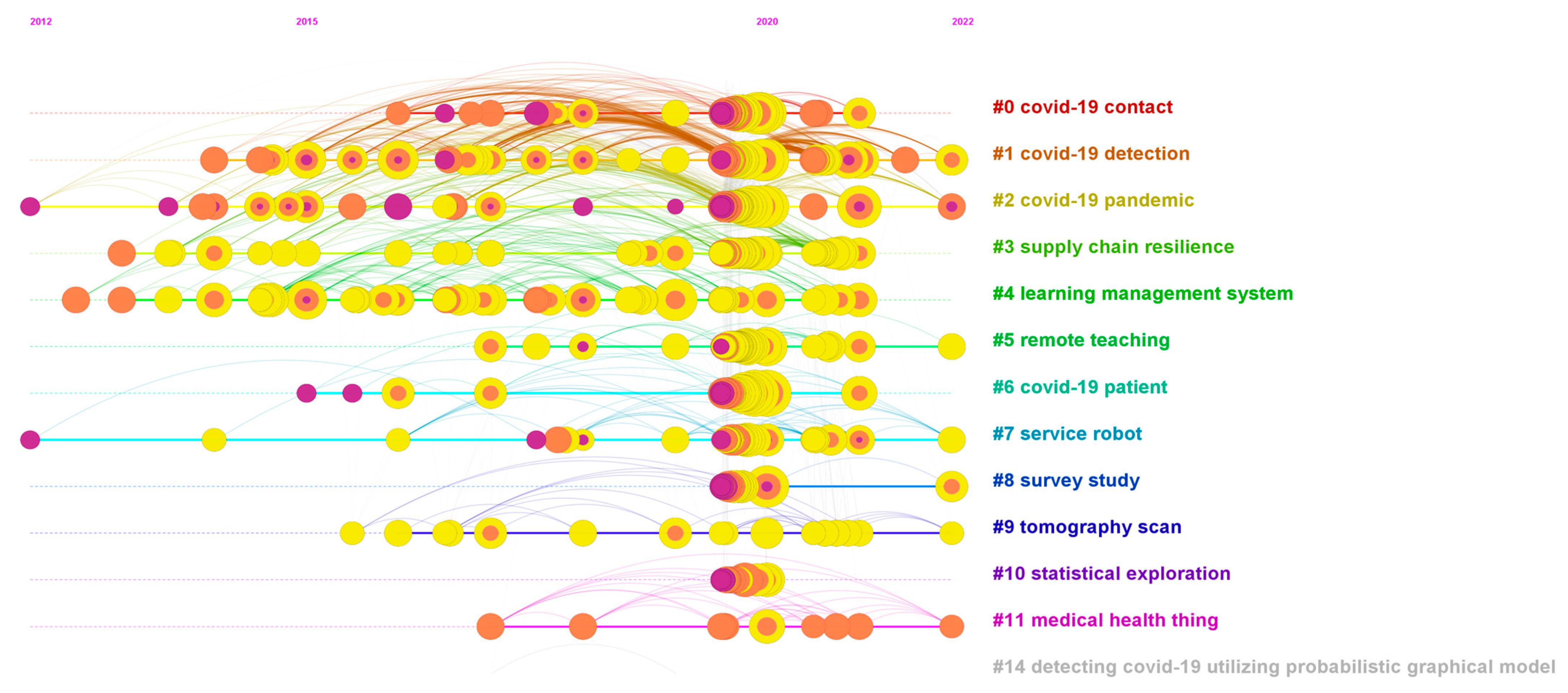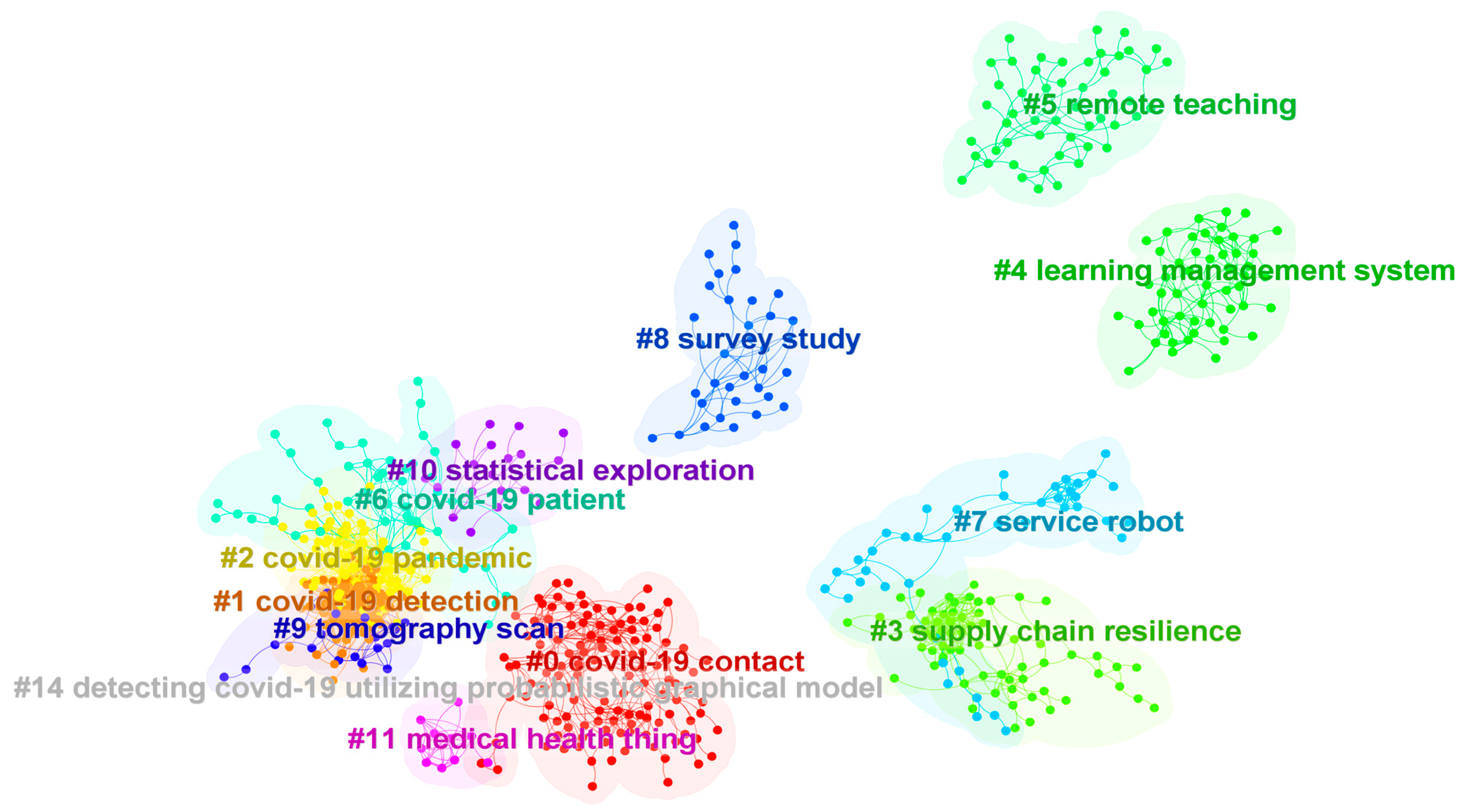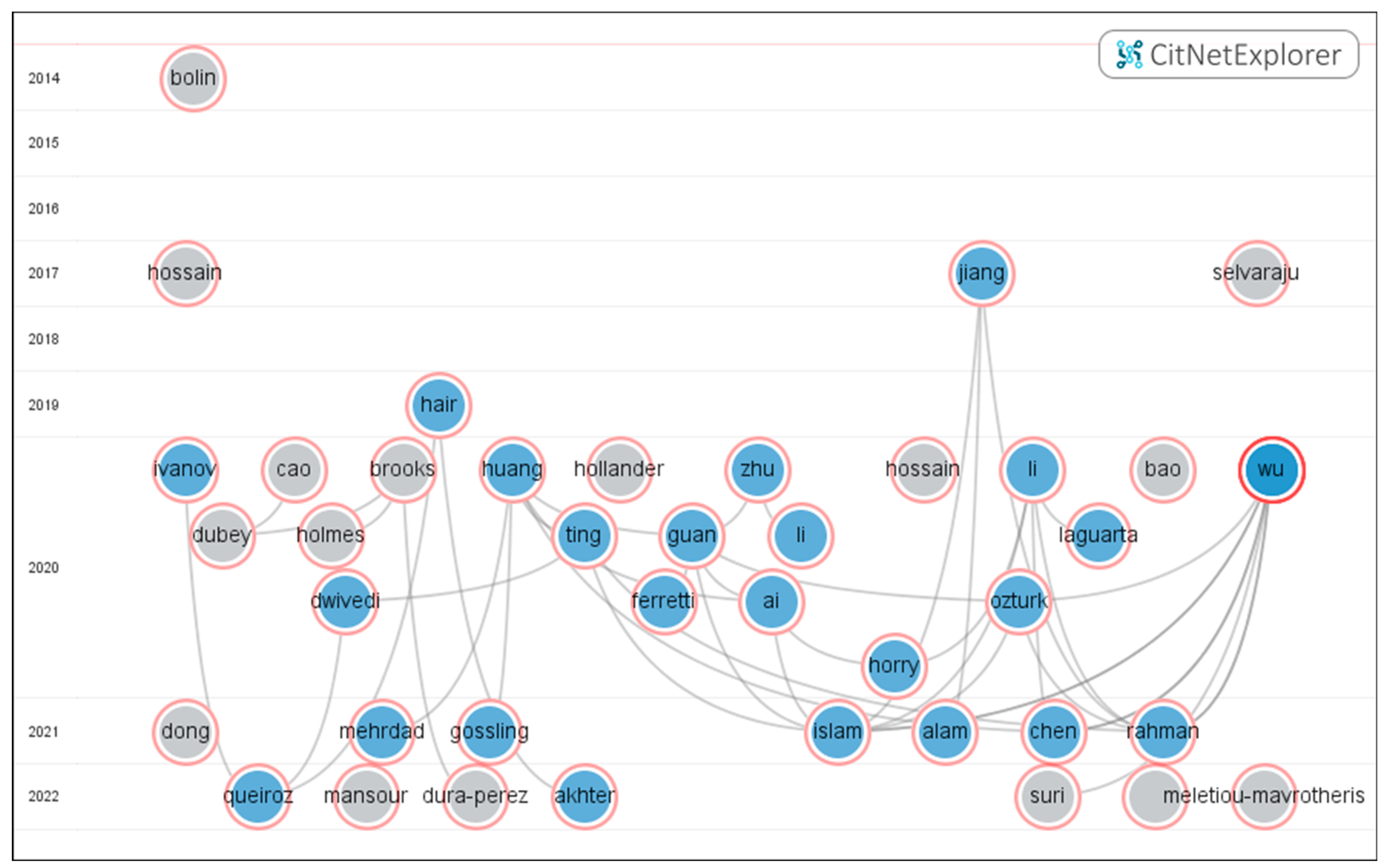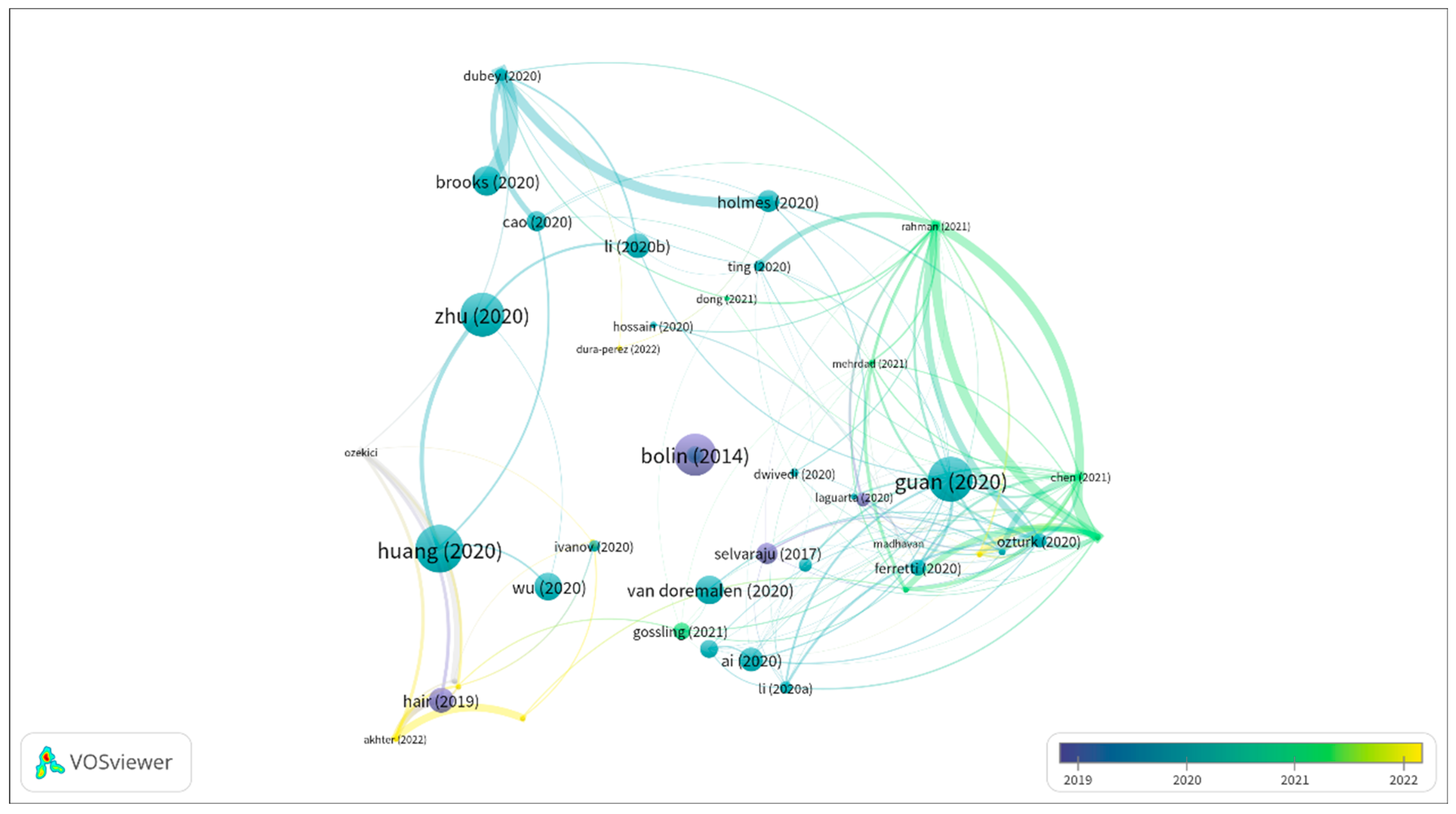3.2.1. Keyword Co-Occurrence Network Analysis
In the keyword analysis process of Citespace, no part of the literature data is included in the analysis scope. Although 11,377 pieces of data were imported into Citespace software, there are only 10,569 pieces identified in the period 2020–2022. In addition, the amount of data is so large that the core keywords are submerged. Therefore, the analysis process needs a screening standard to narrow the analysis sample, then the analysis perspective can focus on the evolution of the core keywords. As shown in
Table 3, the g-index is used to select keywords, which means the number of citations obtained is no less than the square of the g value for a researcher’s first g published papers (ranked according to the number of citations). The number of keywords obtained from the last three 1-year slices is 272, 586 and 599, respectively, and the corresponding number of connections related to these keywords is 816, 1758 and 1797, respectively. The k value in the table is a scaling factor and a parameter in the g-index. If the analysis process needs to obtain larger analysis samples, the keyword network can add more nodes by increasing the k value.
As mentioned above, due to a large number of keywords, this paper only analyzes the core part of the raw data and simplifies the network structure. The network node screening criteria include the g-index (k = 25), LRF = 3.0, L/N = 10, LBY = 8 and e = 2.0. For the parameters, LRF, L/N and LBY are the filtering criteria for network links, which can be used to remove excessive connections. The e value is another important parameter for filtering nodes. Finally, the keyword nodes and links that are selected according to the above criteria form a keyword co-occurrence network, which includes 777 nodes and 4043 network links, and the network density is 0.0134. In addition, according to the processing results of Citespace, the modularity value of the network is 0.5483, the weighted mean silhouette value is 0.7649 and the harmonic mean value is 0.6388. Here, the modularity and silhouette values are the measurement indicators describing the network structure and also the quality indicators evaluating the analyzing effect. These results reflect that the results of node clustering are reasonable, the community boundaries of clustering are significant enough and the homogeneity of clustering categories is low. Through further visualization, the keyword co-occurrence network in the timeline view is shown in
Figure 3, which also shows the main clustering categories of nodes and the keyword evolution path under each category. The keywords in each category have a co-occurrence relationship with other keywords in the same cluster category, and also show a co-occurrence relationship with keywords in different cluster categories.
After switching to the cluster view, the co-occurrence relationship between nodes and the cluster community boundary can be seen in
Figure 4. The clustering categories in this figure are consistent with those in
Figure 3, which is another visual presentation. The nodes in the keyword co-occurrence network are divided into eight main categories.
Further, based on the document clustering analysis, the keyword information in the original data forms a keyword co-occurrence network as shown in
Figure 4. Among the nodes, there are eight main cluster categories. There is a certain overlap of nodes between different categories, which reflects the potential semantic structure relationship in the research field. The labels of each category come from the article title. Citespace applies the LSI, LLR and MI algorithms to generate clusters. The list of labels for each category is shown in the following
Table 4, which supports the interpretation of
Figure 3 and
Figure 4. The label keywords shown in the table can help to understand the meaning of specific clustering categories. In general, LLR is the best way to determine cluster category labels.
Table 4 shows that the largest category (Cluster #0) has 148 nodes, and the silhouette value is 0.745. The most prominent cluster labels generated by LLR, LSI and MI are, respectively, controlled trial, COVID-19 pandemic and 19-derived pandemic. The primary literature citing this category is the study by Dura Perez et al. (2022) [
18]. This article pointed out that restrictive measures for epidemic prevention and control rely on the application of information and communication technology, but the impact of restrictive measures and technology application on the mental health of residents needs further exploration. The three keywords with the highest frequency in this category are health (331), care (224) and mental health (190).
The second largest category (Cluster #1) has 130 nodes, and the silhouette value is 0.686. The most prominent cluster labels generated by LLR, LSI and MI are digital transformation, COVID-19 pandemic and 19-derived pandemic, respectively. The most important literature citing this category is the work of Alam et al. (2021) [
19] This article pointed out that a management information system that can automatically learn should be constructed to adapt to the trend of pandemic evolution and effectively curb the epidemic. The three keywords with the highest frequency in this category are impact (604), COVID-19 (449) and COVID-19 pandemic (378).
The third largest category (Cluster #2) has 114 nodes, and the silhouette value is 0.722. The most prominent cluster labels generated by LLR, LSI and MI are remote teaching, COVID-19 pandemic and 19-derived pandemic, respectively. The most important literature citing the category is the work of Basaran et al. (2022) [
20], which pointed out that the development of COVID-19 has promoted the status of technology in the education process, but the impact of the pandemic on teachers’ technology perception is relatively limited. The three keywords with the highest frequency in this category are higher education (338), education (290) and virtual reality (245).
The fourth largest category (Cluster #3) has 108 nodes, and the silhouette value is 0.831. The most prominent cluster labels generated by LLR, LSI and MI are COVID-19 pandemic, artistic intelligence and 19-derived pandemic, respectively. The literature most closely related to this category is the work of Dong et al. (2021) [
21] The mentioned research pointed out that building an intelligent community that can make full use of the perception ability and seamless connection characteristics based on the Internet of Things, incorporating the technology into the epidemic prevention and control system, is an urgent solution. The three keywords with the highest frequency in the category are artistic intelligence (811), deep learning (376) and machine learning (332).
The fifth largest category (Cluster #4) has 107 nodes, and the silhouette value is 0.814. The most prominent cluster labels generated by LLR, LSI and MI are technology acceptance model, COVID-19 pandemic and 19-derived pandemic, respectively. The literature most closely related to this category is the research of Adegoke et al. (2021) [
22], which pointed out that the main factors for the real estate industry to adopt VR technology during the COVID-19 pandemic include performance expectations, effort expectations, social impacts, convenience conditions, hedonic motives and internal values. The three keywords with the highest frequency in the category are technology (685), model (542) and information technology (458).
The sixth largest category (Cluster #5) has 87 nodes, and the silhouette value is 0.803. The most prominent cluster labels generated by LLR, LSI and MI are medical thing, COVID-19 pandemic and 19-derived pandemic, respectively. The literature most closely related to this category is also the research of Dong et al. (2021) [
21], which shows that Cluster # 5 and Cluster # 3 have potential connections. The three most frequent keywords in this category are system (360), internet (340) and challenge (211).
The seventh largest category (Cluster #6) has 61 nodes, and its silhouette value is 0.759. The most prominent cluster labels generated by LLR, LSI and MI are social media, COVID-19 pandemic and 19-derived pandemic, respectively. The literature most closely related to this category is the study of Patra et al. (2022) [
23] The mentioned study discussed the evolution of fake news during COVID-19, and proposed implementation strategies to deal with information chaos in the digital era. The three keywords with the highest frequency in this category are information (297), social media (275) and communication (135).
The eighth largest category (Cluster #7) has 20 nodes, and the silhouette value is 0.906. The most prominent cluster labels generated by LLR, LSI and MI are remote work, COVID-19 pandemic and COVID-19 pandemic, respectively. The literature most closely related to the category is the work of Mansour et al. (2022) [
24], which pointed out the importance of training digital technology applications for nursing work responding to the COVID-19 pandemic, but there are still some conceptual obstacles preventing staff from accepting new technologies. The three keywords with the highest frequency in this category are work (62), space (43) and resource (41).
3.2.2. Literature Co-Citation Network Analysis
The analysis process of the literature co-citation network is similar to the process of the keyword co-occurrence network. Correspondingly, the network nodes are also divided into three 1-year time intervals.
Table 5 shows the network screening criteria and the network attributes under each time interval. There are 265 articles from 2020 added to the analysis sample, and 795 network links are retained. From 2021, 516 articles and 1548 network links are selected. Moreover, from 2022 there are 441 articles corresponding to 1323 network links remaining.
To further explore the knowledge flow process of literature, this paper uses the co-citation method to analyze the evolution trend of literature citation, thus obtaining the co-citation network of literature under the timeline view as shown in
Figure 5. The network visualization reflects the co-citation relationship between core articles, with 772 nodes and 3244 network links, and a 0.0109 network density. In addition, the modularity value of the network is 0.5447, the weighted mean silhouette value is 0.8942 and the harmonic mean value is 0.677. In terms of the analysis process, co-citation network analysis and keyword co-occurrence analysis have much in common. First, the same network screening criteria are adopted, namely g-index (k = 25), LRF = 3.0, L/N = 10, LBY = 8 and e = 2.0. Second, the text of the clustering labels also comes from the title information of each article. These similarities help to find a connection between the two networks, which can provide a sufficient explanation for identifying key literature. Third, the keyword co-occurrence network shows the mutual relationship of topics, and the co-citation network presents the mutual relationship between literature nodes.
However, unlike the keyword co-occurrence network, the co-citation network reflects more on the knowledge structure evolution. As introduced in
Section 2, the co-citation relationship suggests the knowledge base and research frontiers in a particular research field. The knowledge base is a collection of important articles identified by the citing behavior of frontier articles, which reflects a citation development trajectory. The research frontier is a collection of cited articles identified by the continuous development of frontier literature for a certain research branch. Therefore, knowledge base and research frontier are a pair of interrelated concepts. Through the theory, the literature co-citation network can identify some common references from the analyzed literature samples. These identified references constitute the knowledge base of the research field but do not necessarily appear in the analyzed samples. With the evolution of the knowledge field, some studies have received more attention and the corresponding citations will grow rapidly, which indicates frontier research. By focusing on the knowledge base and frontier research, we can quickly sort out the research context, and then determine the next research direction.
Figure 6 is the literature co-citation network in the cluster view, which shows the distribution of literature nodes in each cluster category. The largest category (Cluster #0) has 123 nodes, and the silhouette value is 0.902. The most prominent cluster labels generated by LLR, LSI and MI are COVID-19 contact, COVID-19 pandemic and vital sign, respectively. The most prominent literature citing this category is the work of Islam et al. (2021) [
25], which reviewed deep learning technology for COVID-19 diagnosis, and pointed out that the unstructured and non-standard data sets are the main challenges for the deep learning application. The most three frequently cited articles in this category are Ting et al. (2020) [
26], Hollander et al. (2020) [
27], Ferretti et al. (2020) [
28].
The second largest category (Cluster #1) has 92 nodes, and the silhouette value is 0.828. The most prominent cluster labels generated by LLR and LSI are the same: COVID-19 detection. In addition, the first label generated by MI is vital sign. The most prominent literature citing this category is the work of Islam et al. (2021) [
25], which is the same as Cluster # 0. The three most frequently cited articles in this category are Oztuk et al. (2020), Apostolopoulos et al. (2020) and He et al. (2016) [
29,
30,
31].
The third largest category (Cluster #2) has 89 nodes, and the silhouette value is 0.717. The most prominent cluster labels generated by LLR, LSI and MI are COVID-19 pandemic, artificial intelligence and vital sign, respectively. The most prominent reference in this category is the work of Ozturk et al. (2020) [
29], and the article proposed a method to automatically detect COVID-19 based on X-ray image technology. The three most frequently cited articles in this category are Ai et al. (2020), Li (2020a) et al. and Fang et al. (2020) [
32,
33,
34].
The fourth largest category (Cluster #3) has 66 nodes, and the silhouette value is 0.984. The most prominent cluster labels generated by LLR, LSI and MI are supply chain resilience, COVID-19 pandemic and vital sign, respectively. The most prominent literature citing this category is the work of Queiroz et al. (2022) [
35], which pointed out that the operation and coordination of supply chain resources are important for coping with the COVID-19 pandemic, and the digital twin method can provide a copy for the enterprise supply chain and improve the alertness level. The three most frequently cited articles in this category are Ivanov (2020), Dwivedi et al. (2020) and Bolin (2014) [
36,
37,
38].
The fifth largest category (Cluster #4) has 53 nodes, and the silhouette value is 0.984. The most prominent cluster labels generated by LLR, LSI and MI are learning management system, COVID-19 pandemic and vital sign. The most prominent literature citing this category is the work of Akhter et al. (2022) [
39], which indicated that technical support and organizational willingness are important factors affecting the online learning effect during the COVID-19 pandemic. The two most frequently cited articles in this category are Henseler et al. (2015) and Hair et al. (2019) [
40,
41].
The sixth largest category (Cluster #5) has 51 nodes, and the silhouette value is 0.932. The most prominent cluster labels generated by LLR, LSI and MI are remote teaching, COVID-19 pandemic and vital sign. The most prominent literature citing this category is the research of Meletiou-mavrotheris et al. (2022) [
42] This mentioned research argued that under the influence of the COVID-19 pandemic, teaching quality and accessibility show a serious trend of inequality, and building a high-quality online learning platform for all learners is very important. The two most frequently cited papers in this category are Dhawan (2020) and Bao (2020) [
43,
44].
The seventh largest category (Cluster #6) has 50 nodes, and the silhouette value is 0.918. The most prominent cluster labels generated by LLR, LSI and MI are COVID-19 pandemic, COVID-19 patient and vital sign, respectively. The most prominent literature citing this category is the work of Mehrdad et al. (2021) [
45], which showed that the use of wearable smart devices can help control the epidemic spread and track specific biomarkers by detecting virus infection symptoms and predicting the infection possibility. The three most frequently cited papers in this category are Huang et al. (2020), Zhu et al. (2020) and Guan et al. (2020) [
46,
47,
48].
The eighth largest category (Cluster #7) has 42 nodes, and the silhouette value is 0.954. The most prominent cluster tags generated by LLR, LSI and MI are service robot, COVID-19 pandemic and vital sign. The most prominent literature citing this category is the work of Özekici et al. (2022) [
49], which pointed out that the anxiety caused by COVID-19 significantly improved users’ acceptance of virtual reality, which provides implications for tourism restoration. The three most frequently cited articles in this category are Gössling et al. (2021), Yang et al. (2020) and Dontu et al. (2020) [
50,
51,
52].
The ninth largest category (Cluster #8) has 35 nodes, and the silhouette value is 0.996. The most prominent cluster tags generated by LLR, LSI and MI are survey study, COVID-19 pandemic and vital sign. The most prominent literature citing this category is the work of Dubey et al. (2020) [
53], which pointed out that the COVID-19 pandemic brought severe psychosocial problems with social event risks, and accelerating digital technology to develop plans to intervene in negative psychological conditions is necessary. The most frequently cited articles in this category are Brooks et al. (2020), Cao et al. (2020) and Holmes et al. (2020) [
54,
55,
56].
The tenth largest category (Cluster #9) has 19 nodes, and the silhouette value is 0.844. The most prominent cluster labels generated by LLR, LSI and MI are, respectively, topography scan, COVID-19 detection and COVID-19 pandemic. The most prominent literature citing this category is the work of Suri et al. (2022) [
57], and the research pointed out that the application of artificial intelligence technology in CT scanning can locate and segment COVID-19 focus faster and more reliably. The most frequently cited articles in this category are Selvaraju et al. (2017) and Horry et al. (2020) [
58,
59].
The eleventh largest category (Cluster #10) has 19 nodes, and the silhouette value is 0.938. The most prominent cluster labels generated by LLR, LSI and MI are COVID-19 pandemic, artificial intelligence and visual sign, respectively. The most prominent literature citing this category is the work of Chen et al. (2021) [
60], which indicated that the application of artificial intelligence in combating the COVID-19 pandemic can seek breakthroughs of data resources, thus improving the application scope and potential. The most frequently cited articles in this category are Li (2020b) et al., van Doremalen et al. (2020) and Wu et al. (2020) [
61,
62,
63].
The twelfth largest category (Cluster #11) has 10 nodes, and the silhouette value is 0.981. The most prominent cluster labels generated by LLR, LSI and MI are medical health thing, artificial intelligence and COVID-19 pandemic, respectively. The most prominent literature citing this category is the study of Madhavan et al. (2021) [
64], which suggested that it is easy to obtain false positive and false negative results with polymerase chain reaction and reverse transcription polymerase chain reaction, thus using CT or X-ray based on artificial intelligence can become an effective alternative to identify patients with COVID-19. The most frequently cited articles in this category are Hossain et al. (2020), Laguarta et al. (2020) and Hossain (2017) [
65,
66,
67].
The thirteenth largest category (Cluster #14) has two nodes, and the silhouette value is 1. The most prominent cluster labels generated by LLR, LSI and MI are detecting COVID-19 utilizing a probabilistic graphical model, artificial intelligence and COVID-19 pandemic, respectively. The most prominent literature cited in this category is the work of Rahman et al. (2021) [
68], which stated that the application of artificial intelligence in the prevention and control of COVID-19 is facing challenges, such as lack of resource support, and legal and ethical risks. The most frequently cited articles in this category are Jiang et al. (2017) and Davenport et al. (2019) [
69,
70] Finally, the main text labels in each category are shown in
Table 6.
3.2.3. Core Literature Identification
As shown in
Table 7, although the keyword co-occurrence network divides keywords into eight main categories, the silhouette value of each category is relatively low, and only the silhouette value of Cluster #7 is higher than 0.9, which indicates that there is a certain topic overlap between various categories. Therefore, on the basis of text mining, the above keyword clustering categories have the potential for integration, thus forming a new category. These keywords provided hints to find the core articles and the analysis process was finished in Citespace. Next, this study used the keywords to conduct a discussion that presents the research evolution. From the analysis results of keywords, the clustering categories mainly reflect three new kinds of topics. The first new category is mainly about public health and medical care, including Cluster #0 and Cluster #1. The second new category is mainly about education, labor, social media and other aspects of social governance, including Cluster #2, Cluster #6 and Cluster #7. The third new category is mainly about artificial intelligence, information technology, the Internet and other emerging technologies, including Cluster #3, Cluster #4 and Cluster #5. Moreover, the distribution of these topics shows that epidemic prevention and control is a systematic project, which requires the cooperation of multiple departments to implement the virus containment strategy.
Table 8 shows the representative articles in the cluster analysis of the literature co-citation network. Similar to the keyword co-occurrence network, the clustering categories of the literature co-citation network also reflect three new types of topics. The first new category is digital technology applications related to COVID-19 diagnosis, including Cluster #0, Cluster #9, Cluster #11 and Cluster #14. The second new category is about other applications of digital technology in the medical process of the COVID-19 pandemic, including Cluster #1, Cluster #2, Cluster #6 and Cluster #10. The third new category is the strategy of social governance and digital transformation of the industrial economy in response to the challenges of the COVID-19 pandemic, including Cluster #3, Cluster #4, Cluster #5, Cluster #7 and Cluster #8. In addition, Cluster #3, Cluster #7 and Cluster #8 are mainly related to the digital transformation of social governance, while Cluster #4 and Cluster #5 are mainly related to the digital transformation of education. The distribution of the above categories further shows that the process of digitalization of epidemic prevention and control needs to be promoted simultaneously from both technical and social governance aspects. The R&D and application of digital technology need to be planned in combination with the needs of social governance, which is based on the premise of effectively containing the epidemic spread.
This study applied CitNetExplorer to analyze the citation relationships between 49 core articles, and the results are shown in
Figure 7. In addition to the timespan 2020–2022, some of the core documents are from 2019 or before 2019. It should be noted that four of the core articles are published online, and cannot be identified by CitNetExplorer and are not shown in the above results. Therefore, 43 citation network links have been formed among the 45 articles analyzed, and 16 articles of the 45 have citation relations in the figure, while the other 29 articles present isolated characteristics. The most-cited article is Huang et al. (2020) [
46], which has been cited six times. The following ones are Li (2020), Guan (2020) and Wu (2020) [
33,
48,
63], which were cited five times, four times and four times, respectively. The citation relationship shown in
Figure 7 shows that there are still close citation relationships within the limited literature scope, which constitutes an important knowledge base in the field of digital epidemic prevention and control research. While other isolated nodes do not form a reference relationship in the figure, these articles have potential topic coupling relationships and reflect different digitalization directions.
As shown in
Figure 8, VOSviewer is used to conduct a bibliographic coupling analysis of 49 identified core articles. The analysis results show five clustering categories, and the fifth category is a combining category that includes all the isolated nodes. 42 of the 49 articles have literature coupling relations. The article of Islam et al. (2021) [
25] has the highest strength of coupling relations, with a total link strength of 41, followed by Dubey et al. (2020), Chen et al. (2021) and Rahman (2021) [
53,
60,
68], and the corresponding total link strengths are 33.33, 39 and 41, respectively.
Through the above bibliometric analysis, we can conclude some common trends. For example, the COVID-19 pandemic is obviously one of the core contents, and digital transformation takes a certain proportion but is not obvious, which reflects that the digital process of epidemic prevention and control is still in the development stage. In addition, the results of the bibliometric analysis also reflect the characteristics of differentiation. In the clustering results obtained with the LLR algorithm, there are many differences in the main categories under various dimensions of literature citation, while the main cluster categories obtained with the MI and LSI algorithms are less different. This result reflects the fact that the LLR algorithm can more effectively explore the topic distribution of literature, while the MI and LSI algorithms are more suitable for testing the consistency of results. Therefore, the core articles can be divided into the following branches for literature review and discussion.
